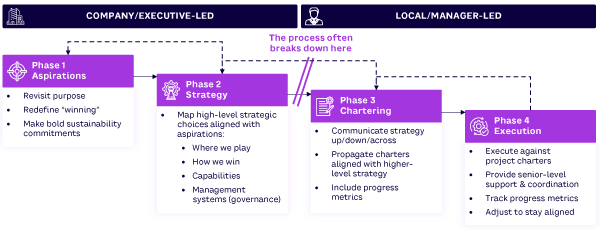Achieving bold sustainability commitments requires changing how business is done and a complete redesign of company strategy. Management consultant and author Roger Martin describes strategy as a cascade of choices that address five questions:
-
What is our winning aspiration?
-
Where will we play?
-
How will we win in chosen markets?
-
What capabilities must be in place to win?
-
What management systems are required?
These questions must be addressed both at a high level by executives and through more specific choices at operational management levels. We break the process of strategic transformation into four phases: aspirations, strategy, chartering, and execution. Figure 1 shows why the flow between these phases is critical to achieving transformational results.

An aspiration defines what winning looks like. It incorporates the company’s purpose and mission, as well as its vision for success. Traditionally, corporate aspirations have been financially grounded, with purpose statements focused on meeting customer needs while delivering shareholder value. Sustainability recognizes the importance of meeting both shareholder and customer needs but goes beyond that to consider the stakeholders of the whole system in which a business operates.
Sustainability aspirations must be connected to the strategy cascade in a way that creates financial value while having a positive environmental, social, and economic impact. We refer to this as sustainable value creation. The logic for an integrated strategy must be clear, addressing potential risks while seeking opportunities to grow the business.
In the chartering phase, middle managers make strategic choices and frame the choices needed at the next level down. “The CEO may initiate the process, but the making and chartering of choices must continue all the way down the hierarchy for effective action to take place,” writes Martin.
This is often where the process breaks down. Organizations struggle with the transition from phase 2 to phase 3: executives roll out a strategy and expect aligned implementation to propagate naturally from top to bottom. Unfortunately, this rarely happens on its own.
What may seem like a clear sustainability strategy to executives often fails to translate into a practical set of strategic choices for managers deeper in the organization and closer to the reality of the business. Without a relevant sustainability strategy for their part of the business, managers stick with business as usual, limiting progress toward corporate commitments. Operating under a traditional strategy, they treat sustainability initiatives as a distraction (or even something harmful to the business) rather than essential to creating business value.
Bridging the aspiration-execution (and results) divide isn’t simple, but it can be done.
[For more from the authors on this topic, see: “How to Deliver on Ambitious Sustainability Commitments.”]





